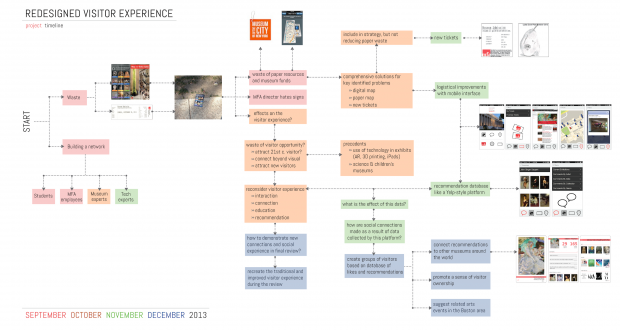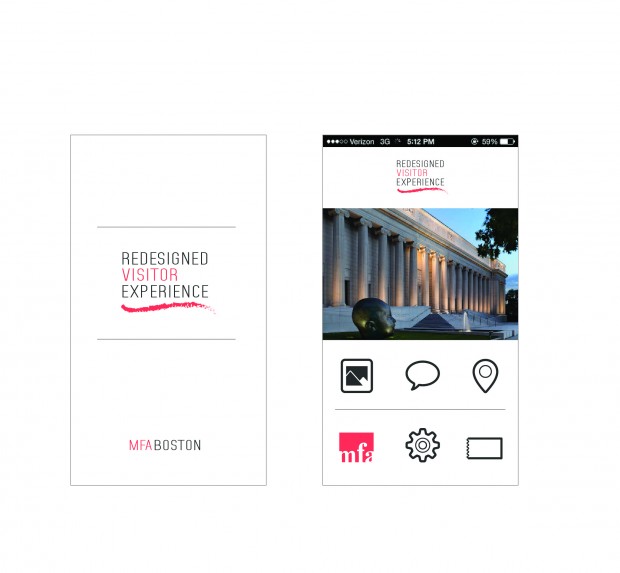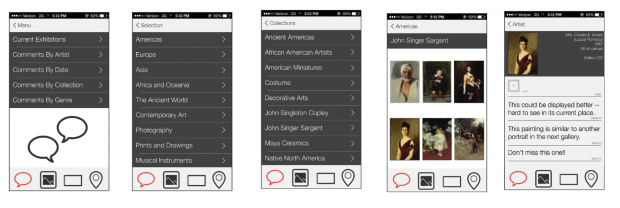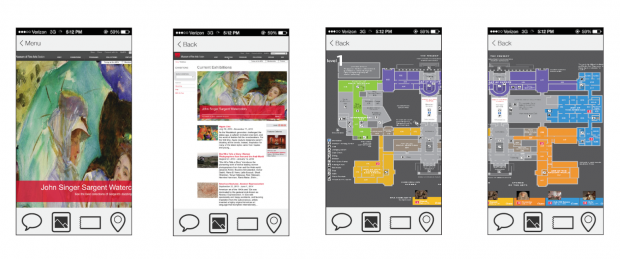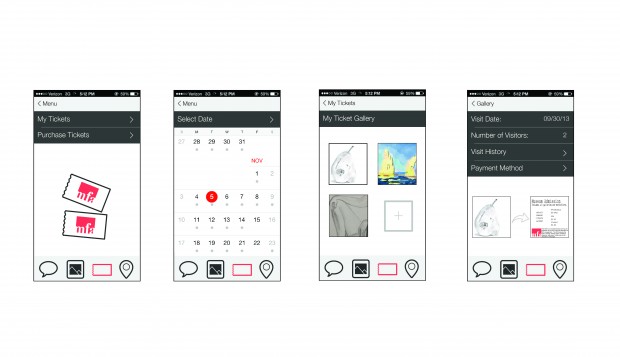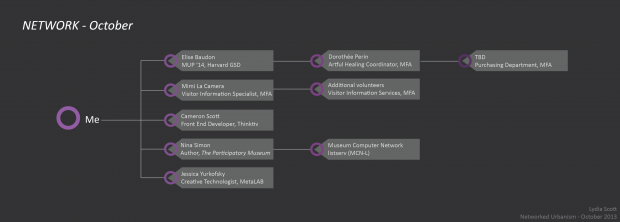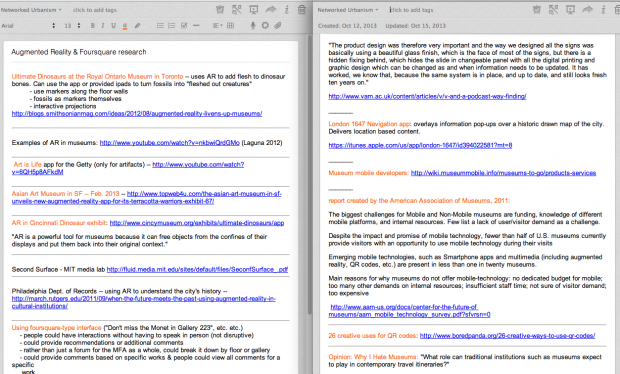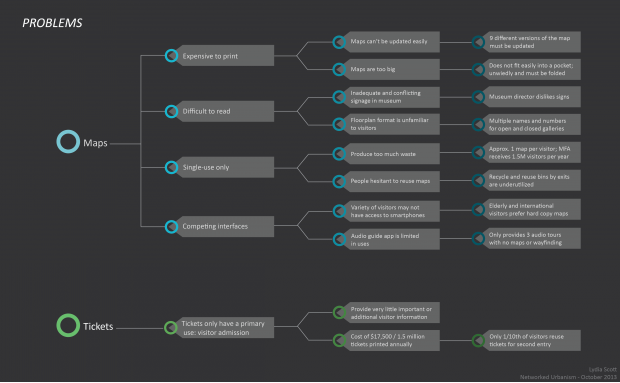Networked Urbanism
design thinking initiatives for a better urban life
apps awareness bahrain bike climate culture Death design digital donations economy education energy extreme Extreme climate funerals georeference GSD Harvard interaction Krystelle mapping market middle east mobility Network networkedurbanism nurra nurraempathy placemaking Public public space resources Responsivedesign social social market Space time time management ucjc visitor void waste water Ziyi
Posts by Scott, Lydia
Redesigned Visitor Experience aims to enhance visitor-to-object connections and create visitor-to-visitor experiences within an art museum. The Museum of Fine Arts in Boston, which welcomes nearly 1.5M visitors annually, was the museum of interest throughout this process.
Initially, the focus was on the waste of physical resources of the museum: the paper used to produce thousands of maps and millions of tickets annually, and the funds required to print this collateral. An app to support logistical improvements, including a digital map, access to the museum’s web catalog, and the opportunity to buy tickets from a smartphone, was the first stage of solutions. Many lower-level members of the museum staff were incredibly helpful in providing initial feedback about the current visitor and wayfinding experience. After several dead-ends and false starts, it was necessary to explore another approach to the museum and its relationship with waste. Though helpful, this type of app was not particularly innovative, and led to a consideration of a waste of opportunity in the form of visitor experience. How can museums encourage connection, education, and interaction, beyond design of the exhibitions themselves? How can data analysis play a role in creating new networks that continue to develop outside of a museum?
In contrast to a science museum or a children’s museum, art museums tend to be more conservative and traditional. Artifacts and precious objects are stored behind glass for safety, with only small plaques of information available. Additional Information is relayed primarily visually and unilaterally: directly between the visitor and object. There is little interaction between visitors, unless they arrived in groups together. Visitors can view the same objects without acknowledgement of a relationship between objects and visitors. Arguably, the quiet of museums allows for enjoyment of the arts, and while this is true there is still a sense that another layer of understanding and connection could exist.
Imagine a digital platform that could promote and support these additional connections, while collecting valuable data for the MFA. For example, a visitor sees a painting that she likes. She simply clicks on its image in the RVEx mobile application, and it will pull up some basic information about the work, including artist, title, and date. The images and the details about all of the museum’s works will be populated by the museum’s own directories of its collections.
She can then tap to access the section for visitor participation. She can view other visitor’s comments and suggestions for the painting, and how many people “liked” and people have seen the painting so far. She has the option to leave a comment, or scroll through previous time-stamped comments. This page operates similarly as if the work had a Facebook profile. The app provides visitors with related objects that they can see in the MFA, if they particularly liked this painting.
A visitor profile allows you to save works that you like to a personal gallery, as well as your recent activity. The visitor can remember the name of a work she loved, share it with others, or just keep it on hand for a return trip to the museum. This app can function as digital pocket gallery, and your favorite art can quite literally be at your fingertips. A visitor can also access groups, settings, and recommendations for international museums, local events, and other pieces of art. This app can be used daily by an art lover, or as a digital way to collect a souvenir when on vacation.
What takes the platform beyond a Yelp or Foursquare review-based platform, this app includes groups. The groups are created based on an analysis of data of a visitor’s activities: what they’ve liked and seen. The museum and the art serves as the starting point for creating these kinds of connections that can eventually flourish beyond the physical space. Perhaps most interestingly, the app intends to provide “group based recommendations.” Again on an analysis of data, suggestions are generated for art found in the MFA that may interest members. Next are recommendations for local events, which pushes the network outside of the confines of museum. Finally, the platform suggests international museums that may be of interest. Eventually, these could have their own similar platforms and catalogs, so you can view and save art, and connect with other members from around the world.
Note about the copyright for images of paintings, sculptures, etc. used in frames from the above presentations: I do not own the images and they are the property of the MFA, from www.mfa.org.
In the middle of November, we were asked to create a proposal for the final review “performance” for former Loeb Fellow Jim Lasko.
Below are initial attempts to create a mobile application to solve the logistical problems associated with digitizing maps and tickets, and beginning to design a visitor-to-visitor commenting platform.
Below is the presentation given during our two-day midterm review on October 22 and 23, 2013.
Development of a resource network — in progress.
Bibliography presentation of one film and one book to further our research on the issue of waste:
Bibliography Presentation 15 October
Continuing research into new types of technology to transform the visitor experience:
Further mapping of issues with the museum’s current paper-based tickets and maps:
Initial exploration and proposals for paper items offered for museum visitors:
Research Presentation 10.01.13
Bringing a bit of the museum to class, instead of bringing the class to the museum.
10.01.13 Experience Presentation
Jennifer Lee Mills & Lydia Scott
Scott, Lydia
It appears that Scott, Lydia hasn't tweeted anything yet.
